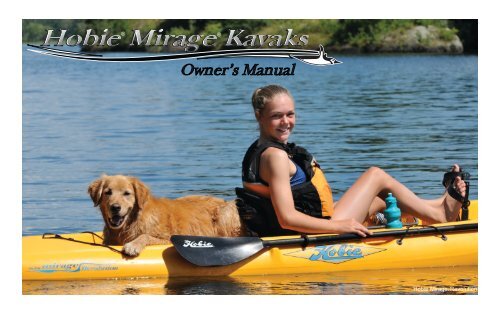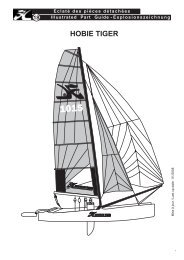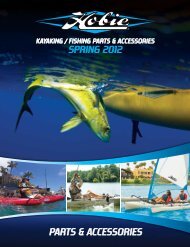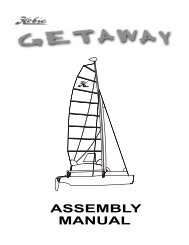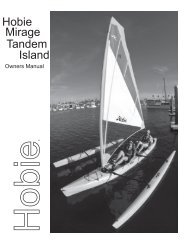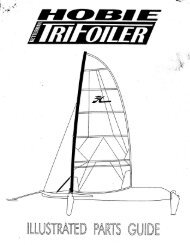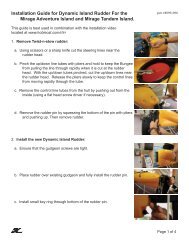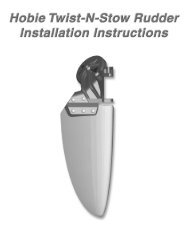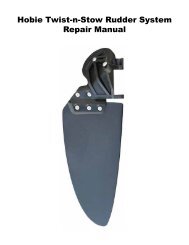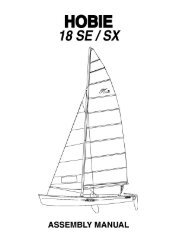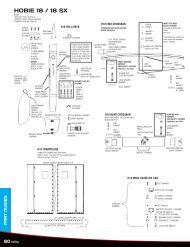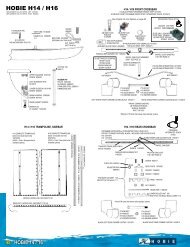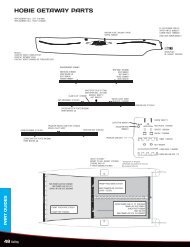Hobie Mirage Kayaks Owner's Manual - Hobie Cat
Hobie Mirage Kayaks Owner's Manual - Hobie Cat
Hobie Mirage Kayaks Owner's Manual - Hobie Cat
You also want an ePaper? Increase the reach of your titles
YUMPU automatically turns print PDFs into web optimized ePapers that Google loves.
® ®<br />
<strong>Hobie</strong> <strong>Mirage</strong> <strong>Kayaks</strong><br />
Owner’s <strong>Manual</strong><br />
<strong>Hobie</strong> <strong>Mirage</strong>® Revolution
Welcome to the <strong>Hobie</strong> Way of Life<br />
Thank you for choosing a <strong>Hobie</strong> <strong>Mirage</strong> Kayak. As a member of the <strong>Hobie</strong> way<br />
of life, you are now on the road to pure adventure in pedaling and paddling. This<br />
owner’s manual is designed to help you get maximum enjoyment from your new<br />
<strong>Hobie</strong> kayak. But more important, it is designed to help you use it safely. The<br />
content of this manual covers all <strong>Mirage</strong> kayaks.<br />
1
Sit-on-top Cockpit<br />
<strong>Hobie</strong> <strong>Mirage</strong> <strong>Kayaks</strong> are open-top cockpit designs. This<br />
allows the kayaker to enter and exit the kayak easily<br />
from the shore, dock or water. Scupper hole(s) make the<br />
kayak self-bailing. The design also eliminates the need<br />
to perform an “Eskimo roll” (advanced kayak technique).<br />
The contoured seat is fitted with an adjustable backrest for<br />
added comfort.<br />
About the Design of your Kayak<br />
2<br />
Hull Design<br />
The long center “keel” area encourages the kayak to track<br />
straight when pedaling, paddling and coasting. Under<br />
moderate paddling conditions, the wider “shoulder” area<br />
of the hull rides high at the surface of the water without<br />
compromising speed. If the kayak is fully loaded with gear<br />
or is being paddled and braced in rough conditions, the<br />
“shoulder” areas provide secondary buoyancy and stability.<br />
Maneuverability<br />
Most new <strong>Mirage</strong> <strong>Kayaks</strong> come with the patented Twist- and-<br />
Stow rudder system. This system comes pre-installed by our<br />
factory. This new rudder is designed to flip out of the way<br />
during land transport and has an optional larger rudder blade<br />
for more turning authority.<br />
Scupper Hole(s)<br />
Drain holes (scuppers) in the cockpit or cargo well allow any<br />
water that enters the cockpit to immediately flow back out.<br />
Graphics<br />
Graphics are molded into the kayaks, so they will not peel or<br />
flake off for the life of the boat.
Drive Installation<br />
1. The <strong>Hobie</strong> <strong>Mirage</strong>Drive® must be<br />
lowered into the opening of the hull<br />
near the footwells so it is facing forward<br />
and evenly front to back. The front of<br />
the <strong>Mirage</strong>Drive can be determined by<br />
the location of the fin masts. Tipping<br />
the drive forward or aft when lowering<br />
can cause it to wedge into the well and<br />
possibly cause damage to the hull and/<br />
or fins. The <strong>Mirage</strong>Drive alignmenet pin<br />
helps prevent this, so make sure that it<br />
properly seats in the groove.<br />
<strong>Hobie</strong> <strong>Mirage</strong>Drive<br />
Stainless<br />
Steel Masts<br />
FORWARD<br />
2. To lock the <strong>Mirage</strong>Drive into the hull, lower it into the hull<br />
so that the drum shaft posts drop down into the Click and Go<br />
cams and lock into place.<br />
3. To remove the <strong>Mirage</strong>Drive, flip the<br />
Click and Go cam back and pull the drive<br />
out. The cams should automatically reset<br />
themselves for installation, but if they do<br />
not, just flip the cam forward.<br />
Alignment<br />
Pin<br />
3<br />
Pedal Adjustment<br />
The pedals of the <strong>Hobie</strong> <strong>Mirage</strong>Drive are adjustable to<br />
accommodate different leg lengths of kayakers. To adjust<br />
the pedals:<br />
1. Squeeze the adjuster<br />
handles located on the pedal<br />
cranks.<br />
2. While squeezing the<br />
adjuster handle, move the<br />
pedal crank to the most<br />
comfortable position. Similar<br />
to a bicycle, it is best to adjust<br />
the pedals so your legs do<br />
not fully extend causing your<br />
knees to lock. Make sure that<br />
the metal pin on the crank fully<br />
engages the adjustment hole.<br />
3. <strong>Hobie</strong> <strong>Cat</strong>® recommends new<br />
users have the pedal length adjustment set in the middle<br />
(number 4) to help while installing it into the hull correctly.<br />
Once installed you can select your preferred length setting.
Drum Casting<br />
When turning the nut with a 7/16 inch<br />
open-end wrench, only giving it one half<br />
a turn at a time, then do the same to<br />
the remaining three nuts. Re-check the<br />
tension and adjust accordingly.<br />
Note: Keep the pedal shafts and masts parallel. When the<br />
shafts are together, both masts must be straight down. The<br />
idler pulley cable (see item B in the illustration below) will<br />
be tightened automatically when the front chain assembly is<br />
tightened.<br />
Cable Adjustments<br />
Determining if adjustment is needed...<br />
Occasionally the cables may need to be<br />
re-tightened. The cables should be kept<br />
taut; however, the front chain should be a<br />
little tighter than the rear chain. Push with<br />
your thumbs at the points marked (A)<br />
with moderate pressure (see the image<br />
to the right). The side of the chain should<br />
not go beyond the inside edge of the<br />
drum casting.<br />
B<br />
A A<br />
4<br />
Washing<br />
After using in salt water or dirty water, wash the <strong>Hobie</strong><br />
<strong>Mirage</strong>Drive with fresh water. Allow to dry, then spray metal<br />
parts with WD-40 or equivalent. Special attention should<br />
be paid to threaded cable ends, lock nuts, chain, shafts, pedals,<br />
and adjustment pins.<br />
Miscellaneous Maintenance<br />
Periodically check for loose screws or frayed cables. If a<br />
cable has a broken strand, replace it with new cable.<br />
CAUTION<br />
Care should be taken to avoid striking objects with the<br />
<strong>Hobie</strong> <strong>Mirage</strong>Drive. If you bend a mast, it usually can be<br />
straightened. To straighten, remove the <strong>Mirage</strong>Drive from<br />
the boat and insert the Drive into something solid, such as<br />
a vise. Remove the fin, then carefully bend the mast until<br />
straight. To test for "true", roll the mast on a flat surface and<br />
straighten as needed until the masts roll evenly. If the mast<br />
cannot be straightened or becomes cracked or fatigued,<br />
replace the mast.
Twist And Stow Rudder Features<br />
The <strong>Hobie</strong> Twist and Stow rudder system is pre-installed<br />
and adjusted at the factory. With extensive use, the rudder<br />
system may need to be adjusted. The following information<br />
is intended to familiarize you with the rudder and how it<br />
works.<br />
The left steering<br />
control line is tied<br />
off at the screw<br />
here.<br />
Twist and Stow Rudder System<br />
The right steering<br />
control line passes<br />
up through the hole<br />
here and is tightened<br />
down with<br />
the small screw<br />
alongside it.<br />
5<br />
The left steering control line<br />
passes up through the hole in<br />
the hex head bolt.<br />
These bolts give you the ability<br />
to change between a larger or<br />
smaller rudder blade.<br />
For improved performance with the<br />
kayak sailing option, an optional<br />
larger rudder blade is available.
Up/Down Control Assembly/ Operation<br />
The following detail explains how the up/<br />
down rudder control is set up inside the<br />
kayak.<br />
Pulley<br />
Steering Control Trim<br />
To achieve a good, responsive feel with<br />
the steering system, you may occasionally<br />
need to adjust the tension of the steering<br />
lines (follow the diagram at right).<br />
These two screws hold the end of the<br />
line in place. Turn back the screw a<br />
couple of times to release the end of<br />
the line and tighten the screws back<br />
down to hold the line.<br />
Bungee® Attached<br />
to Cord<br />
6<br />
T Handle: There are two T-handles on the kayak that operate<br />
the up/down control funtion of the rudder. Simply pull on the UP<br />
handle on the right to raise the rudder and the DOWN handle on<br />
the left to lower the rudder. When the rudder is down, pull the line<br />
tight and pull it into the cleat near where the T-handle exits the<br />
hull. This will make sure that it firmly stays down.<br />
Pull more of this line<br />
and wrap it around the<br />
screw to trim your boat<br />
to the left.<br />
Pull more of this line<br />
to trim your boat to<br />
the right.
Basic Kayak Features<br />
Basic Kayak Information<br />
<strong>Hobie</strong> <strong>Mirage</strong> Oasis<br />
The front of the boat is the “bow” and the rear is the “stern”.<br />
When looking forward to the bow, the left side of the boat is<br />
“port” and the right side is “starboard”. The hull ID number<br />
can be found on the bottom of the boat, at the stern.<br />
In the middle of the boat, there is a cockpit area, with the<br />
seat (toward the stern) and footwells (toward the bow). Inside<br />
the cockpit are scupper hole(s) that go all the way through<br />
the boat. These scuppers allow the boat to drain. All <strong>Hobie</strong><br />
<strong>Mirage</strong> kayaks have hatches that allow access to the inside<br />
of the boat for gear storage.<br />
Alongside the cockpit are a series of small “U” straps, called<br />
padeyes. These are used to attach accessories such as<br />
backrests.<br />
7<br />
All <strong>Hobie</strong> kayaks are made of linear polyethylene, making<br />
them repairable and recyclable.<br />
Recommended Equipment for Specific Types of Pedaling<br />
and Paddling<br />
Basic Boating: Life Jacket, Paddle, Paddle Leash, Backrest,<br />
Safety Whistle, Filled Water Bottle, Appropriate safety equipment<br />
depending on weather and location.<br />
Longer Distance Touring: Dry Bags, Chart, Compass.<br />
Additional Equipment for Diving: Dive Flag, Anchor.<br />
Fishing: Rod Holders, Rod Leash, Rod Holder Extensions<br />
Gear Bags, Livewell, Anchor or Stakeout Pole, Fish Grips,<br />
Visibility Flag.<br />
Safety<br />
Kayaking can be dangerous and physically demanding. The<br />
user of this product should understand that participating in<br />
kayaking may involve serious injury or death. Observe the<br />
following safety standards when using this product. These<br />
are basic safety rules that all boaters should follow. Always<br />
use common sense and follow all safety rules at all times.
Safety Checklist<br />
· To avoid damage to the <strong>Hobie</strong> <strong>Mirage</strong>Drive, push either pedal<br />
completely forward before beaching or in shallow water. Use<br />
small, partial pedal strokes with one pedal nearly all the way forward<br />
until there is adequate water depth for the <strong>Mirage</strong>Drive to<br />
have complete clearance in the water.<br />
· Consult your physician prior to beginning<br />
paddle/pedal sports.<br />
· Always carry the spare paddle provided with the boat.<br />
· Obtain paddle/pedal sports instructions from your dealer specific<br />
to this type of craft.<br />
· Obtain certified first aid training and carry first aid and rescue/<br />
safety equipment.<br />
· Always properly wear a Coast Guard approved personal flotation<br />
device.<br />
· Wear a helmet where appropriate.<br />
· Dress appropriately for weather conditions; cold water and/or<br />
weather can result in hypothermia.<br />
· Check your equipment prior to each use for signs of wear or<br />
failure.<br />
· Never pedal or paddle alone and file a float plan.<br />
· Always tie a leash to your paddle.<br />
· Do not pedal or paddle in flood conditions.<br />
· Care must be made to ensure that the access hatches on your<br />
kayak remain closed while on the water. Water can enter a hatch<br />
that is left open and possibly flood the hull making the boat unstable<br />
or cause inadequate flotation for the passenger(s).<br />
· Be aware of appropriate river water levels, tidal changes, dangerous<br />
currents, obstacles in and above the water and weather<br />
changes.<br />
· Scout unfamiliar waters; portage where appropriate.<br />
· Do not exceed your paddling/pedaling ability; be aware of your<br />
limitations.<br />
8<br />
·<strong>Hobie</strong> <strong>Kayaks</strong> were not designed for fast moving water.<br />
· Follow the manufacturer’s recommendations for use of this product.<br />
· If additional outfitting is added to this craft, use manufacturerapproved<br />
materials only; do not impair entry or exit access.<br />
· Read owner’s information package prior to using this product.<br />
· The user of this product acknowledges both an understanding<br />
and assumption of the risk involved in paddle/pedal sports.<br />
· When paddling in a new area, check with the locals regarding<br />
currents, shoreline conditions and weather patterns. Plan an<br />
“escape route” -- an alternative place to get off the water should<br />
environmental conditions dictate. Beware of offshore winds that<br />
may make it difficult to return to shore.<br />
· DO NOT use alcohol or mind-altering drugs prior to or while<br />
using this product.<br />
The Shakedown Cruise<br />
As with any new product, it is important that you become familiar<br />
with the craft and all its features. It is also important to determine<br />
if the kayak is sound before long trips. We recommend that you<br />
do what we call a “shakedown cruise” when the kayak is new,<br />
after shipping or transport, before long trips and after installing any<br />
through-hull fittings. This test is typically done in shallow, calm<br />
conditions where you can familiarize yourself with the boat or test<br />
the boat before taking any long trips into open water. Things that<br />
you should check or practice are:<br />
· Rudder Operation<br />
· <strong>Mirage</strong>Drive Adjustment<br />
· Getting in and out of the kayak from a capsized state<br />
· Drain plug locations to make sure they are properly installed<br />
· Closing the hatches properly<br />
· Taking the kayak sail down on the water (if applicable)
How to Perform a Self Rescue<br />
If you fall out of your boat, don’t panic. Stay with the boat.<br />
You should be wearing a life jacket which will keep you afloat.<br />
There are many ways to get back up on the boat.<br />
If the boat is upside-down, it will need to be turned over.<br />
To do this, reach across the bottom of the boat and grab<br />
the scupper hole or <strong>Hobie</strong> <strong>Mirage</strong>Drive and pull the boat<br />
upright.<br />
Position yourself so your head is near the cockpit area of the<br />
boat and you are facing the boat. You will want to be between<br />
the seat and the footwell areas of the boat.<br />
Reach across the boat to the far edge with one hand. Place<br />
the other hand on the near-side rail, then kick with your feet,<br />
pulling yourself up and onto the boat, so your belly is across<br />
the center line of the boat. (Your belly should end up between<br />
the footwells and the seat.)<br />
Next, roll over onto your backside toward the seat, which<br />
should place your backside in the seat. Sit up, swing your<br />
feet into the footwells and you’re ready to go.<br />
The key to this method is to keep your center of gravity low<br />
and near the centerline of the boat. Your body and head<br />
should stay close to the boat.<br />
CAUTION: While righting the <strong>Hobie</strong> <strong>Mirage</strong> or climbing back<br />
aboard, stay clear of the pedals, pedal shafts, sails and<br />
adjustment straps. Avoid being hit by them or getting them<br />
hooked on your life jacket.<br />
9<br />
If your kayak turns over with the kayak sail up, it can be very<br />
difficult to turn the kayak over by rolling just the kayak. Make<br />
sure that the mainsheet is loose so that the sail is free to<br />
move around.<br />
Pedaling<br />
First, adjust the pedals to accommodate your size as shown<br />
earlier in these instructions. Adjustments can be made for a<br />
variety of leg lengths. Adjust the pedal positions equally. Sit<br />
with one pedal all the way forward so your knee stays slightly<br />
bent when your leg is fully extended. Then you simply pedal<br />
back and forth to propel the boat forward. For pedaling in<br />
shallow water, partial strokes with one pedal forward and one<br />
aft allow for retractment of the sails in shallow water. When<br />
there is adequate water for clearance of the fins, full strokes<br />
can be used. For additional speed you can paddle as well<br />
as pedal.<br />
Before beaching or launching, push one pedal completely<br />
forward to retract the <strong>Hobie</strong> <strong>Mirage</strong>Drive fins up against the<br />
hull and pull up the rudder. To take off from the beach, push<br />
out to deeper water or paddle out before putting the rudder<br />
down and pedaling the <strong>Mirage</strong>Drive.<br />
If launching from a rocky or wavy shore, paddle into<br />
deeper water before installing it to avoid damage to your<br />
<strong>Mirage</strong>Drive. (Be sure to tether the <strong>Mirage</strong>Drive to you kayak<br />
when it is not installed.) You may also prefer to remove the<br />
drive before beaching.
Paddling<br />
You can choose to paddle,<br />
pedal or combine the two.<br />
These guidelines will help you<br />
to get started.<br />
To start, sit in your kayak.<br />
Your backside should be all<br />
the way back in the seat and<br />
your knees comfortably bent.<br />
To find the proper footwell,<br />
straighten your legs all the<br />
way out and then bring them<br />
back one footwell. If your legs<br />
are too outstretched, you may experience strain on your<br />
lower back. If your knees are bent too much, you may end<br />
up knocking your kneecaps while paddling.<br />
For proper hand placement on your paddle, start with your<br />
hands about a shoulder’s width apart. If you place the center<br />
of the paddle on top of your head, your elbows should form<br />
slightly less than a 90 degree angle. There should be an<br />
equal amount of paddle shaft beyond each of your hands.<br />
Some paddles may have the blades offset, or “feathered”,<br />
at some degree from parallel. A feathered paddle presents<br />
less surface area for the wind to catch as that blade moves<br />
forward through the air. Some paddles have a flattened spot<br />
10<br />
along the paddle shaft that will help keep your “control” hand<br />
in a fixed position. However, a special technique must be<br />
used to get each blade in the water. If the paddle is righthand<br />
controlled (when the right blade is held vertical, the left<br />
blade “scoop” is pointed mostly up), the right hand will stay<br />
tight and the left hand loose. To learn the process, hold the<br />
paddle tight in your right hand and loose in your left. Using<br />
the right hand, rotate the paddle blade back and forth; it<br />
should spin in your left hand. Now take a stroke on your right,<br />
then cock your right wrist back (left hand staying loose and<br />
somewhat open) and take a stroke on your left. If using a<br />
left-hand control paddle, reverse the process. The left hand<br />
stays tight and the right hand loose.<br />
The basic paddle stroke will give you forward power. Place<br />
a paddle blade in the water near your toes. Pull the paddle<br />
blade back alongside the boat to approximately your hip area<br />
while your opposite hand and paddle blade move forward.<br />
Then lift the first paddle blade out of the water while lowering<br />
the second blade into the water and take a stroke with the<br />
other side.<br />
If you pull the paddle out and away from the hull in an arc, it<br />
will force the bow of the boat to swing away from the paddle<br />
blade. This is called a “sweep stroke” and is used to turn the<br />
boat.
<strong>Mirage</strong> Cassette Plug<br />
You <strong>Hobie</strong> <strong>Mirage</strong> kayak is shipped with a <strong>Mirage</strong> Cassette<br />
Plug. The plug is provided as standard equipment in the<br />
<strong>Mirage</strong> Kayak package and is used to fill the space where the<br />
<strong>Mirage</strong> fits into the hull. It is inserted when the <strong>Mirage</strong>Drive<br />
is removed to provide added safety and to “fair” the bottom<br />
of the hull when paddling.<br />
To install the cassette plug, simply place the plug in the hole<br />
for the <strong>Mirage</strong>Drive mechanism and lock it down using the<br />
Click and Go cams.<br />
11<br />
Storing Your <strong>Hobie</strong> Kayak<br />
<strong>Hobie</strong> has chosen a blend of plastic that has an added<br />
measure of ultraviolet inhibitors to provide superior protection<br />
from ultraviolet light. However, to ensure extra years of<br />
use and bright colors, avoid storing the boat where it will be<br />
exposed to weather or in direct sunlight.<br />
<strong>Kayaks</strong> should be stored upside down on the cockpit rails, or<br />
suspended in the air. When hanging your kayak, make sure<br />
that the ropes or straps support most of the weight on the<br />
cockpit rails or the side of the boat. A word of caution: hanging<br />
by the scupper hole(s) may cause distortion, and hanging<br />
from the handles may place undue strain on them. Storing<br />
the boat bottom-side down may also cause distortion. Kayak<br />
storage systems are available from your dealer. Padeyes are<br />
NOT intended for hanging or for use as tie-downs.<br />
To help prevent theft of your kayak, simply run a cable<br />
through a scupper hole and lock it to something secure.
Plug-In Seatbacks<br />
<strong>Hobie</strong> <strong>Mirage</strong> seatbacks use<br />
a locking plug-in method of<br />
attaching to the hull.<br />
1. Line up the plugs<br />
underneath the vencro flap on<br />
the seat so that they are in line<br />
as shown here. Press them<br />
into the plugs in the seat area.<br />
2. Press in and turn the seat<br />
pegs 90 degrees clockwise to<br />
lock them in place.<br />
3. Fold down the plug handles<br />
and lay the velcro flap over<br />
the plug.<br />
We recommend that the<br />
seatbacks be removed while<br />
car-topping your kayak.<br />
Transporting Your <strong>Hobie</strong> Kayak<br />
The easiest way to transport your <strong>Hobie</strong> kayak is to purchase<br />
a roof rack from your dealer. They come with a wide<br />
12<br />
variety of attachments from kayak saddles to stackers. The<br />
racks can be used without the attachments but the racks<br />
should be padded. To help prevent distortion, place the<br />
kayak, cockpit side down, on top of the rack. Straps can<br />
then be laid across the boat and tied to the bars. Saddles<br />
cradle the boat and often come with their own straps.<br />
An alternative to traditional rack systems are soft racks. They<br />
tend to be less expensive and will work with most cars. These<br />
are pads mounted on straps that sit between the kayak and<br />
the roof of your car. Some styles have a strap that wraps<br />
around the kayak and others strap the pad to the roof. To tie<br />
the boat to the car, straps are run through the car doors and<br />
the boat is tied to the roof as well as the bumpers, front and<br />
rear. Over-tightening the straps may cause dents in the roof<br />
of the car. Be sure to first consult your owner’s manual for<br />
the car and roof rack system to ensure that you comply with<br />
all of their recommendations, precautions and specifications.<br />
A line run from the bow and stern of the boat to each<br />
bumper is required. If your bumpers do not have a gap to<br />
pass a rope around, look underneath. There should be a loop<br />
of metal, which is used by car transports such as tow trucks.<br />
Many people like to use the scupper holes to tie the boat to<br />
the car. This helps prevent the boat from sliding back and<br />
forth or the tie-down rope from slipping off the kayak. (This is<br />
a perfectly acceptable method for tying the boat down.
How can I replace the screw-in fittings (if equipped)?<br />
You may find it necessary to replace some of the padeyes<br />
or hooks if they are damaged. To replace them, follow the<br />
instructions below.<br />
1. Drill two 3/16” holes opposite one<br />
another on the top surface of the screwin<br />
fitting. Be careful not to go all the way<br />
through the part and into the kayak.<br />
2. Insert the two prongs of a pair of<br />
needle nose pliers into the two holes<br />
and rotate the part counterclockwise.<br />
3. Grip the new part with your pliers<br />
and install it into the hole. Be sure to<br />
put a little pressure into the hole so that<br />
the threads on the new part install in<br />
properly.<br />
Is my boat repairable?<br />
<strong>Hobie</strong> kayaks are very durable; however, on occasion they<br />
may need some minor repairs. Linear polyethylene is repairable.<br />
Check with your dealer concerning repairs for your<br />
kayak.<br />
Frequently Asked Questions<br />
13<br />
Is my boat recyclable?<br />
Yes, <strong>Hobie</strong> will recycle your boat when you are done with<br />
it. To recycle a <strong>Hobie</strong> Kayak, it must be cut up so it fits in a<br />
box with the following dimensions (for UPS): may not exceed<br />
130” length plus girth, and 108” in height. Ship the boat to:<br />
<strong>Hobie</strong> <strong>Cat</strong> Company<br />
4925 Oceanside Blvd.<br />
Oceanside, CA 92056<br />
It is our hope that no <strong>Hobie</strong> Kayak will ever end up in<br />
a landfill!<br />
What is the best way to use the scupper plugs?<br />
The scupper plugs are useful when<br />
you would like to keep the inside of<br />
your boat dry and is most helpful<br />
in calmer water conditions. Simply<br />
press the plug firmly into the scupper<br />
hole from the top side of the boat. To<br />
prevent loss of the plugs, lanyards are<br />
provided with the plugs so that you can<br />
attach them to the boat.<br />
Attach lanyard here
Warranty Information<br />
It is very important that you fill out and send us your Warranty Registration Card as soon as possible. This information<br />
enables <strong>Hobie</strong> <strong>Cat</strong> Company to contact you should there be important product information that needs to be shared with you in<br />
a timely manner. Please complete the Warranty Registration Card in your Owner’s Packet, or take advantage of our hasslefree<br />
online option at;<br />
http://www.hobiecat.com/support/warranty-registration/<br />
To file a warranty claim for a product defect, please see your Authorized <strong>Hobie</strong> <strong>Cat</strong> Dealer. They will be able to assess<br />
the problem, assist with a repair and file a warranty claim with <strong>Hobie</strong> <strong>Cat</strong> Company if needed. All warranty claims must go<br />
through your Authorized <strong>Hobie</strong> <strong>Cat</strong> Dealer. The Warranty Registration Card and Warranty Policies are included with each<br />
model in the Owner’s Packet.<br />
14
HOBIE CAT COMPANY<br />
4925 Oceanside Blvd.<br />
Oceanside, CA 92056<br />
Phone (760) 758-9100<br />
Fax (760) 758-1841<br />
REV D 6/2011<br />
PN 89500


